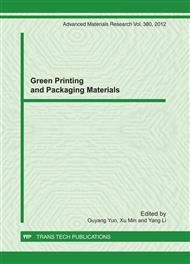p.77
p.81
p.85
p.89
p.95
p.99
p.103
p.107
p.112
The Influence of Emulsification on the Rheological Properties of UV Curable Offset Ink
Abstract:
There is more and more wide application of UV offset ink in green printing and packaging areas. The offset ink is emulsified inevitably and it will cause a great influence on the ink properties. UV offset ink samples prepared with different prepolymers. Base on the measurements of flow curve, thixotropy and dynamic viscoelastic properties under different emulsification ratio to explore the influence of emulsification on the rheological properties of UV offset ink as well as the effect on the rheological properties with different prepolymers at maximum emulsification ratio. The results indicated that the ink viscosity, thixotropy and dynamic viscoelastic properties decline as the increase of emulsification ratio. Compared with polyester prepolymer ink sample that the emulsified ink sample with epoxy prepolymer shows a faster declined in viscosity, lower thixotropy and larger G’ value. This variation trends relate to the viscosity and net structure of the emulsified ink system.
Info:
Periodical:
Pages:
95-98
Citation:
Online since:
November 2011
Authors:
Keywords:
Price:
Сopyright:
© 2012 Trans Tech Publications Ltd. All Rights Reserved
Share:
Citation:


